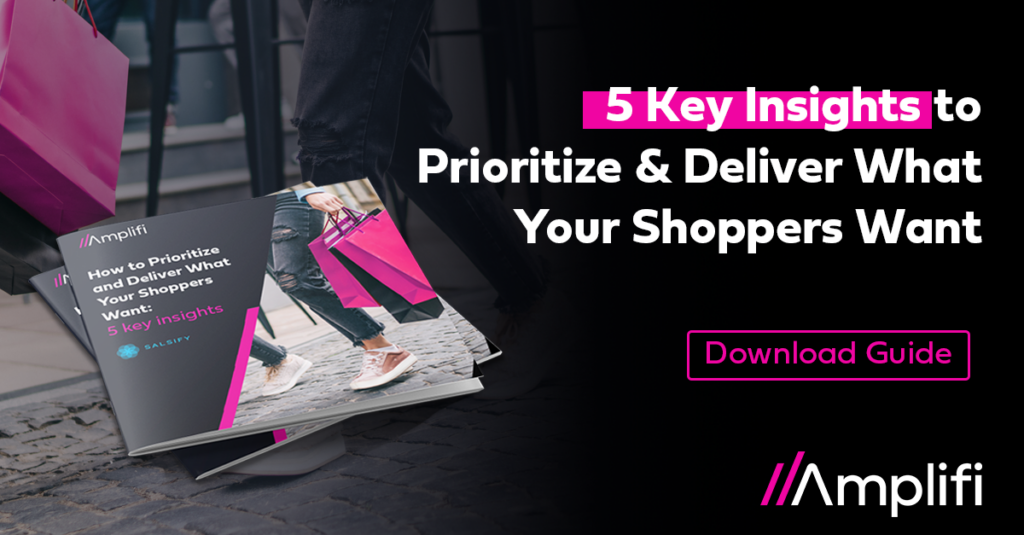In the fast-paced fashion world, retailers and brands find themselves at a crossroads.
On one hand, consumers crave the latest trends at a lightning pace. On the other hand, amidst a sea of unvetted sellers, trust in a brand’s reputation has become a key factor influencing purchase decisions.
So, how can retailers and brands reconcile the need for speedy fashion with practices that build brand loyalty? The answer lies in harnessing well-managed data and its invaluable insights.
In this post, we’ll explore a recent consumer study by our partner Salsify. And we’ll share our insights into data-driven strategies to help you meet the demands of trend-conscious consumers while championing ethical choices.
Fashion consumers want it both ways
First things first: it’s crucial to understand what today’s fashion consumer expects. Insights shared by PIM leader Salsify point to two key factors impacting fashion retailers and brands.
#1: The “I Want It Now” Phenomenon
Today’s consumers have unprecedented access to the latest fashion trends through smartphones and social media. Images and videos, often shared during designer runway shows, generate excitement well before the actual pieces hit store shelves. The traditional timeline of bringing these trends to market, which can take up to six months, means the items can become obsolete before they’re even available for purchase.
Consumers want the hottest styles now. When that doesn’t happen, sales can slump and consumers lose trust. To survive in the “I want it now” digital era, fashion brands must find strategies to deliver their products to consumers faster.
Trend #2: The Call for Brand Trust and Sustainability
On the flip side of fast fashion, consumers prefer brands with a mission. They expect companies to prioritize employees’ well-being, advocate for social and environmental issues, and remain transparent about their efforts to protect the planet.
A recent international survey by London Research and Trustpilot revealed that 82% of consumers would either definitely (31%) or probably (51%) stop buying from a brand lacking ethical standards.
Brands and retailers also face a moral imperative. According to Columbia University, fashion is responsible for 10% of human-caused greenhouse gas emissions and 20% of global wastewater, using more energy than the aviation and shipping sectors combined.
Fashion brands must adopt transparent practices to meet the call for trust and sustainability. This includes choosing sustainable materials whenever possible and openly sharing information about materials and manufacturing processes on websites and social media.
Creative solutions can help, too. For example, you could allow customers to exchange old clothing and upcycle those items to support circular fashion. Or give back to the community with charitable acts like “one purchase = one tree planted.”
Fashion by the Numbers: The Impact to Revenue and Loyalty
Salsify has also studied consumers’ shopping patterns, publishing a 2023 report: How To Prioritize and Deliver What Your Shoppers Want.
These findings shed light on a cycle in the fashion industry of quality, experience, and brand trust.
For example, one way to combat the effects of “fast fashion” is to sway consumers to purchase higher quality—and likely higher priced—items. But how do you sway consumers to pay higher prices?
According to the study, when shopping online, 72% of consumers said that “better reviews” would support paying a higher price, while 61% wanted “a brand name you trust.”
Here are a few other interesting findings:
- 82% of consumers said product quality increases their loyalty, while 57% noted that an excellent online shopping experience does the trick.
- Speaking of online shopping, 94% of U.S. consumers buy clothing online.
- When asked which features are most important for the online shopping experience, the top 4 included positive reviews (52%), trusted brand name (48%), a good return policy (35%), and sustainability (25%).
These findings point to a cycle where product quality and sustainability build trust, which is reinforced by a compelling online shopping experience. When these elements converge, positive reviews become a catalyst to boost purchases and loyalty.
In this context, data emerges as the linchpin that combines all these elements. In the next section, we’ll explore the potential of well-managed data for fashion retailers and brands.
Fashion’s data revolution is here
In the fashion industry, well-managed data is a significant competitive advantage. Brands that use data to nail the customer experience across products and channels will come out on top.
Here are four areas where data can make a significant impact:
Customer Data helps you understand what truly matters to your customers.
Companies can tailor offerings and experiences by analyzing customer data to meet evolving expectations. Understanding purchasing behaviors and preferences can help you make informed decisions around product assortment, pricing, shopping experiences, and marketing strategies.
Product Data is instrumental in tracking sustainability and improving product quality.
By leveraging product data, you can monitor and optimize sustainability aspects like materials, manufacturing processes, sourcing, and certifications. This helps you manage, track, and measure your company’s environmental impact.
Furthermore, optimizing product detail pages and digital search functions based on data insights helps shoppers find products that align with their needs, reducing the likelihood of returns and enhancing brand loyalty. Digital assets play a crucial role, providing the images and videos that help consumers understand exactly what they’ll receive.
The product lifecycle is another area where data makes an impact — helping you enhance product quality and meet customer expectations for faster product releases.
Don’t forget the Supplier Data side of fashion success.
By tracking and analyzing supplier data, your business can partner with suppliers that align with specific values and sustainability standards. This helps maintain transparency throughout the supply chain and supports decisions around partnerships, contract negotiations, and more.
Location Data provides context that helps optimize cost and environmental impact.
Analyzing location-related data helps your company optimize operations and find opportunities to reduce transportation costs and carbon emissions. This data-driven approach supports smarter decisions about manufacturing locations, distribution centers, and transportation routes to reduce costs and lower your environmental impact.
The perfect match: Amplifi and Salsify
This just scratches the surface of what’s possible with the right data processes, people, and technology.
By embracing the power of data, fashion retailers and brands can navigate the delicate balance between consumer expectations, sustainability, and the fast pace of fashion.
When it comes to fashion data, Amplifi and Salsify are your perfect match. We’ve designed successful data programs for some of the world’s leading fashion brands in athleisure, outdoor/hiking, apparel essentials, work wear, and beyond. Together, we know the data needs of the fashion industry best.
 Want to learn more?
Want to learn more?
We’ve compiled some of our recent fashion data insights into a new guide. It’s a quick and fun read, so download your free copy here:


